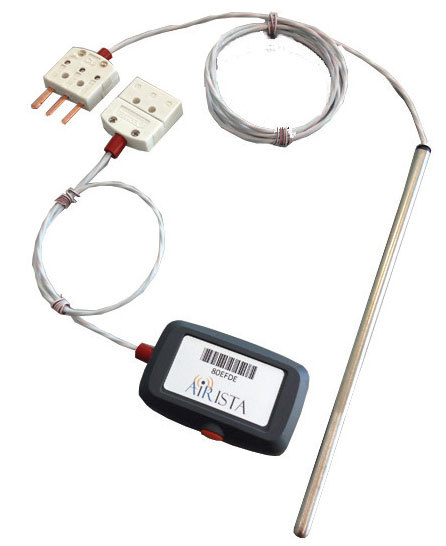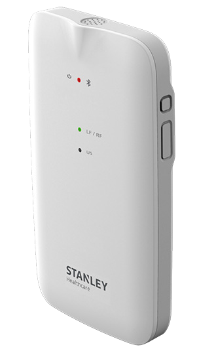A couple of common misconceptions about RFID and Wi-Fi radio channels (and RFID as Wi-Fi points)

RFID-tag for patients so that they can be seen on the hospital map
- Can you sew a chip into each builder’s head?
- Theoretically, yes, but maybe explain why you need it?
- They steal our building materials. Right during the work. And so everyone will see where he went there, where not necessary.
The project was decided by embedding RFID tags in the uniform, dividing the construction into zones and then with what is done on the network when building the perimeter. That is, building a profile of “white” traffic - who, where and when goes. And then - like on a firewall - the builders were banned from everything else. Theft immediately declined. The foreman received otherworldly strength and saw almost every joint.
And then every damn time, when I talk about the RFID solution, people begin to wave their hands and confuse these tags with Wi-Fi, Bluetooth and passive resonant circuits. One reason is that some RFID tags really work over Wi-Fi 802.11. Let's talk about how this is used in practice in different countries.
Passive and Active RFID
There are two kinds of RFID tags. The first are those that do not have their own on-board power and simply resonate in a magnetic field. Such you most often see in stores from bookstores to clothes, and even on sausage in the grocery. They are very cheap, small and reliable, if the attacker does not have a bag woven from wire according to the principle of the Faraday cage.

Passive tags
Active tags are no longer a resonant, but a self-emitting circuit. The signal is broadcast continuously and at a significantly greater distance. Active tags are more expensive, more, but they can produce more data. Active tags, obviously, are much easier to read - respectively, the readers themselves will be two orders of magnitude smaller and an order of magnitude less demanding on power.

Active tags
The usual operating range for a passive tag is 3 meters, for an active one - 100-500 meters.
“Large” active labels, so as not to get up twice, are equipped with different sensors. The ability to continuously monitor and transmit a signal to the radio makes it possible to broadcast the level of temperature, humidity, notify of shocks and shocks, the level of vibration, show the level of illumination, gas contamination (including quality, for example, only with carbon dioxide), broadcast the level of radiation. And writing logs to internal memory - 512 kilobytes no longer seems fiction.
The listed tags are very actively used in different industries.
RFID over Wi-Fi 802.11
Now we get to the most interesting and large RFID tags. These are 802.11-compatible radio devices that broadcast on frequencies from 2.4 to 2.4835 GHz or 5.8 GHz to 5.825 - in those very "household" ranges. And their charm is that they are “out of the box” are full-fledged parts of the Wi-Fi infrastructure and do not require any intermediate protocols or interfaces for communication.

Not everyone supports 5GHz - for example, this 802.11 b / g / n, 2.4GHz
Patients will not go far
The label as in the picture above the post was introduced in a foreign hospital. She clung to the patients on the belt. It transmits basic telemetry without additional lotions - just the position of the patient (in the case of a hospital - the closest emitter corresponding to the ward or corridor). If you press on it with your finger along the recess, you can call your sister, if you press hard or fall face down on the floor with the mark - instead of the sister, the doctor will come running right away.
It is 802.11 b / g / n, the signal power is + 11.5dBm, 2.4 - 2.4835 GHz, the protocol is UDP / IP or DHCP, 16 Mbit / s at 40 meters, 6 Mbit / s at 100 meters are declared. Open / WPA2 protection, the battery is not removed, dies in the cold in a day or two, there is a certain class of protection against rain. Size - approximately like a cockroach from the "Fifth Element", 3x5 centimeters and a little less than a centimeter in height. It weighs 2 grams (so much blood in a mouse-vole). The back of the clip or Velcro.
The hospital in Canada put these marks on the staff too - just see what can be done next. It turned out that with the help of such things you can greatly improve the safety of performing various procedures, optimize patient flows, simplify the work of maintaining a log for security, and monitor all sorts of different parameters from external sensors. The best story is a nasty squeak if you don’t wash your hands when you come from the “dirty” zone.
Final - the introduction of tags on all valuable equipment. They simply started by quickly searching for items such as beds, stretchers and wheelchairs, but then they realized that telemetry could be removed from instruments. And they connected all medical monitors, ventilators, etc. to notifications a la Zabbix.
Search for freeloaders in production
Another interesting implementation was made at the American manufacturing complex. To begin with, each container and each individual accounting unit (pallet or box) was equipped with a passive RFID tag in order to keep an accurate record of products and know what and how is spent. Already this alone somewhat reduced, as the report wrote, “non-production losses” - it seems that they are stealing in America as fun as in factories familiar to us.
Then the tags were hung on the uniform of the workers - this is done according to the requirements of labor safety. On the part of the tags there is the “lone worker” function, when you need to move or pull the tag once every 5-10 minutes. Didn’t - she squeals disgustingly, and after 15 seconds SOS is sent.
Then, by monitoring the flow of workers and materials, production analysts began to look for problems. We found a couple of manual procedures that were completely unnecessary at the plant, automated part of the processes, unloaded the internal logistics due to the correct location of warehouses and the correct accounting of shifts. In general, they were able to make sure that the workers did not stand idle and did not wait for something, but constantly worked. At the last stage, they were going to do integration to automatically assign tasks to employees in real time (at the time of implementation, this was done at the beginning of the shift).
And the finale is the automation of transport and material accounting journals, quick inventories and residue control.
At school
For one American school, they introduced RFID + Wi-Fi in a very original way. Each student has a regular Wi-Fi-compatible tag, and teachers have small Wi-Fi terminals with the ability to send and receive messages.

On the basis of ARiSTA Flow, the
Headmaster can send messages to teachers, and teachers can respond with recorded templates like “understood,” “urgently come up,” etc. The same system is activated by fire alarm and other emergencies - teachers receive information about where to go derive a class, that is, in fact, an escape route.
In each class there is a reader (Wi-Fi access point), which “sees” and counts students. The attendance log is generated automatically. The school intranet is connected to a server that looks on the big Internet, and parents can log in from the application or directly through the web form and see where their children are sitting in the school, and diaries at the same time.
The most interesting thing was done on the school bus, which collects children in the area. Children with tags get on the bus, and there is almost the same functional infrastructure installed, and parents can make sure that the child is sitting properly and see the bus on the map (he gives the coordinates of his GPS sensor).
Teachers began to hang separate tags on projectors and other equipment in order to know where it is located exactly, so the school’s inventory markup is still in the project.
What does it look like
One example of a solution is Cisco RFID over Wi-Fi.
Mobility Services Engine (MSE) aggregates signal strength data from all wireless devices and sends them to the MobileViewc application. MSE also provides a rich set of functions, starting with security - Cisco CleanAir, location detection of unauthorized devices, intrusion prevention systems via Wi-Fi (wIPS) and location analytics.
Or MobileView is a web-based application for displaying asset movement tracking, including alerts based on movements in specified zones.

RFID tags with telemetry, call buttons, temperature and humidity sensors.
Here are the staff tags:

Range Outdoor range: Up to 200m (650 feet) Indoor range: Up to 80m (260 feet)
Physical and Mechanical Dimensions (incl. Flange): 80mm x 40.6mm x 20mm (3.14in x 1.60in x 0.8in) Total Weight (Incl. Retractable reel): 53g (1.86oz). Radio 802.11 b / g / n compliant (2.4 GHz) Low frequency receiver for chokepoint detection (125kHz) Transmission power: up to + 19dBm (~ 81mW) Patented clear channel sensing avoids interference with wireless networks. Ultrasound Receiver Frequency: 40KHz.
Works up to 2 years without battery replacement. Depends on the configuration in the system.
It includes an ultrasonic transmitter with a frequency of 40kHZ, these signals are distributed only within the room, which is necessary for the accuracy of the location detection system. An RFID tag through ultrasound receives a request from a special transmitter, which is installed in the room, and sends a response via Wi-Fi, determining the location of the person.
Asset Tags:


45mm x 31mm x 18mm (1.7in x 1.2in x 0.7in) Weight: 26g (0.92oz), Radio 802.11 compliant (2.4 GHz) Low frequency receiver for chokepoint detection (125kHz) Transmission power: up to + 19dBm ( ~ 81mW) Patented clear channel sensing avoids interference with wireless networks. Ultrasound Receiver (optional) Frequency 40KHz.
This tag has a 3.6V replaceable battery. Duration of work - up to 4 years. The tag sends charge information to the MobileView system. The tag is equipped with a motion sensor, and in case of movement, it begins to send a signal to the monitoring system. The transmission interval is adjustable from 1 second to 3.5 hours. It includes an ultrasonic transmitter with a frequency of 40kHZ, these signals are distributed only within the room, which is necessary for the accuracy of the location detection system. An RFID tag through ultrasound receives a request from a special transmitter, which is installed in the room, and sends a response via Wi-Fi, determining the location of the asset.
Tag Setting Device:

Radio Wi-Fi 802.11 (2.4 GHz); b / g / n compliant * Bluetooth 4. 1 (2.4 GHz) * Low Frequency receiver (LF) 125kHz Transmission power: Up to + 19dBm (~ 81mW). This is a sensor, this device allows you to quickly configure RFID tags.
Ultrasonic LF transmitter (different options): The





ultrasonic transmitter is connected to the LAN and powered by PoE. It constantly sends a request at a frequency of 40 KHz. At this frequency, the signal propagates only within the premises where the transmitter is installed. When an active RFID tag appears in the room, it receives a signal and transmits its data via Wi-Fi to the MobileView monitoring system. There are several types of LF transmitters; they differ in signal transmission range and mounting capabilities.
Thanks to these devices, it turns out to save charge on active tags, because the tag when leaving the zone of operation of the LF transmitter can turn off and stop transmitting information via Wi-Fi.
In general, I hope it has become a little clearer how this works. In Russia, the use of such tags is still extremely rare, but we are already preparing the first major implementations. If there are questions not for public discussion, then my mail is AChuvilin@croc.ru.
